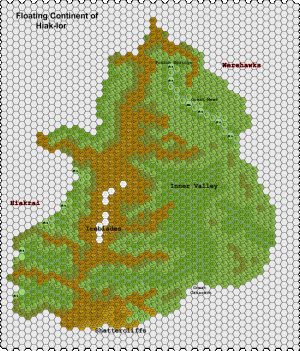
Map of Hiak-lor (Floating Continent)
by WingofCootGreat Cataract: While many streams and rivers cascade over the side of Hiak-lor, this waterfall is by far the largest. Its top is the lowest point of Hiak-lor's habitable upper surface.
Iceblades: The highest part of the central mountain range, the Iceblades have many peaks over 20,000 feet (relative to the Great Cataract) and significant glaciation.
Inner Valley: The only major area of relatively flat terrain on Hiak-lor, home to a Hiakrai splinter culture.
Shattercliffs: The southern end of Hiak-lor was altered by a collision with a smaller floating island several thousand years ago. This is now a broken and barren landscape of rock.
--
I tried to preserve the general shape and size of Hiak-lor from Sturm's map of Floating Continent orbits in Threshold #9.
--
Overall Geography
Hiak-lor has a massive mountain spine running the length of the Floating Continent; spur ridges run outward from this. Most of the rest of the Floating Continent is hills. Many springs arise in the mountains and hills of Hiak-lor, and multiple river valleys cut through the hills. Even the river valley forests are often marked by notable slopes; only in the large Inner Valley are there significant areas of approximately flat terrain.
Climate
Hiak-lor's climate is unusual by the standards of Earth or Outer Mystara, most closely approaching that of tropical highlands, but the lack of day-night temperature variation makes it distinct from that as well. However, a mild seasonal variation gives a similar overall temperature range, "midwinter" only being about 20-25 degrees cooler than "midsummer". There are two "summers" and two "winters" per orbit.
Frost never occurs in the lower elevations of Hiak-lor. The Floating Continent is protected from the cold and thin atmosphere around it, though its own high elevations grow colder as normal.
At the lowest elevations, in the lower reaches of the river valleys, the midsummer temperature is in the mid-80s F and the midwinter temperature in the low 60s. Rain and clouds also influence temperatures locally. Clouds and rain are extremely common on the central mountain range, rare elsewhere; most of the water for the rest of the Floating Continent is provided by springs and streams ultimately originating as rain falling on the mountains. During a rain, temperatures are generally 5-10 degrees lower than otherwise.
The Hiakrai do not live above 4,000 feet, where the midsummer temperature is in the low 70s F and the midwinter temperature about 50 F (except during rain or dense clouds).
Frosts begin at about 8,000 feet (only during rain or cloudy conditions); frost lasts through midwinter above 9,000 feet. The forests rapidly change tree types, then dwindle to scattered conifers grow among rocky slopes and boulders, in this area; tree line lies at about 9500 feet and snow line at about 11,000. Above 12,000 feet, the temperature never rises above freezing; the major glaciers lie above this altitude.
